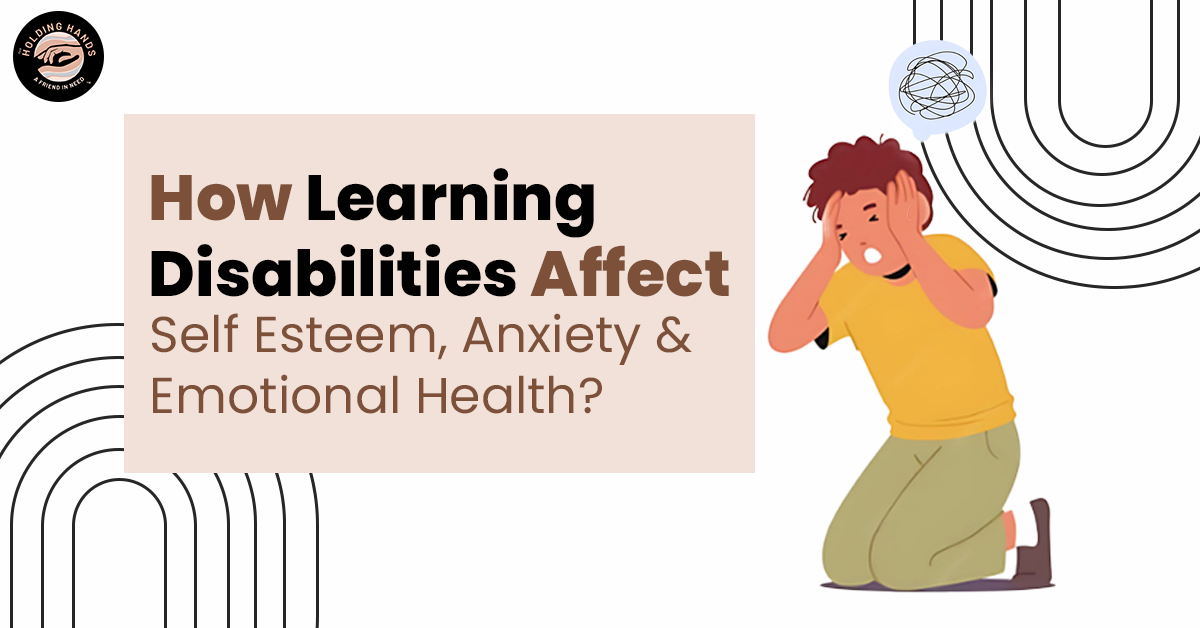
Imagine a life that, in a single moment, leaves a person and their family struggling with a new permanent reality. Once full of life, a treasured family member is restricted to a wheelchair. Someone with a physical disability like paralysis would have the emotional grieving phase, starting with denial, shock, anger, rage, anxiety, alienation, and slow acceptance of the situation. Often, following the psychological path of adapting to any handicap, whether acquired accidentally or known throughout a lifetime.
Table of Contents
ToggleAccording to UNICEF, there are nearly 240 million children with disabilities worldwide, representing approximately 1 in every 10 children. This offers a strong foundation for grasping the emotional disturbance also present with a lifelong ‘learning disability diagnosis.’ Some lives transform overnight, while others go through a slower, more insidious change. Unlike a physical injury from an accident, a learning disability is usually an intangible handicap that shows itself slowly over time. There is a series of growing difficulties, not one traumatic event.
Let’s uncover how a learning disability affects a child and the difficulties they face throughout their life. We will also glance at the different types of learning disabilities, along with a few real-life examples.
What Do You Understand By The Term “Learning Disabilities”?
A neurological condition called a specific learning disability (SLD) modifies how a person’s brain is connected. This shapes their intake, organization, recollection, and expression of data. It is essential to remember that having an SLD does not necessarily reflect a person’s intellect; most people with an SLD have average to above-average intelligence.
The term is occasionally misunderstood as a learning issue that may be conquered with extra time or modifications in learning approaches. An SLD is a lifelong condition that demands continuous assistance.
From kindergarten, a child may feel discomfort or that something is not exactly right; this sense increases with each grade. A parent might first deny the issue, citing the teacher or their school system. Secondly, assuming their parents believe they are stupid, a child may become infuriated at the diagnosis.
What Are The Types Of Learning Disabilities?

1. Dyslexia
It is a learning disability that has affected nearly 10% of the global population, resulting in difficulties in speaking, reading fluently, and understanding words. The struggle is above books and homework. It is hard to understand jokes and idioms, and not be able to find the right words to say in a conversation, or understand body language.
Read Also: Understanding Dyslexia: Symptoms and Types
2. Dysgraphia
Dysgraphia is a learning disability that affects 5% to 20% of school-going children. In such cases, an individual’s ability to exhibit clear and consistent writing is required. People with dysgraphia may intensely dislike writing and lose interest or struggle to organize their thoughts.
3. Dyscalculia
It is a disability that causes an individual to struggle with arithmetic concepts and logical sequences. The problem goes beyond the classroom; it has affected 2% to 8% of the global population. A person might not know how to handle a budget or read a bus schedule.
4. Nonverbal Learning Disorder (NVLD)
NVLD generally challenges the way an individual perceives the world around them. For example, reading a map feels like solving a puzzle, and they are unable to understand body language. They won’t understand a basic task because their brains translate signals and sequences differently.
Read Also: ADHD: Causes, Symptoms, Treatment, and Prevention
How to Help a Child with a Learning Disability?
Identifying learning challenges in the early years can change a child’s development route, and it helps boost their confidence. The brains of young children are most fragile and adaptable in the first three years of life, making strong positioning more effective when help is provided at the beginning. Parents and relatives are a child’s closest and primary support system, but they must channelise their own feelings of sorrow and denial.
A person should overcome their emotions and reach a phase of acceptance; they can now obtain and guide their child. This requires a broader perspective, and parents must reframe their thinking about the disability and then talk to their child in a way that doesn’t damage their confidence.
- It is important to provide a child with their language to describe themselves and their thoughts. Parents and relatives must support a “growth mindset” by celebrating efforts rather than just grades. This teaches the child that trying their best is enough and their efforts are valued.
- Cognitive Behavioral Therapy (CBT) has been effectively adapted in such cases. Therapists use visuals, symbols, and simple sign language to help children identify and create a thought pattern with a more practical approach.
- Social skills training is another appropriate way to help an individual cope with learning disabilities emotional effects because many of the emotional and social challenges are unsettling. So, focusing on present-day problem-solving empowers a child with coping skills for daily life.
Read Also: Understanding Autism Types, Causes, Symptoms, and Treatments
Examples Of Learning Disabilities

Frustration, Anger, and Grief: Huge numbers of people manifest these emotions through feelings of deep rage and of being wronged. Emma, a woman, told about her wrath, which was caused by being a “victim” of her situation and her irritation with being “unfairly handicapped” by society.
This is most commonly associated with the theme of losing something, grieving the ‘normal life’ that they think has been taken away from them, a life in which even the smallest things would not be considered huge battles.
Shame and the Need to Hide: Being judged is always a frightening feeling. People tell about themselves doing a lot of things to conceal their problems, for example, wrapping their books so nobody can see that they read very slowly or not going into any place that could have exposed their difficulties.
Some individuals even create a character, selecting the “class clown” or the “bad kid,” as it seems to be a lesser amount of shame than if one is the “dumb kid.”
How Do Learning Disabilities Affect Self-Esteem?

In addition to the plainly seen hardships with reading, training, and writing or arithmetic, and psychological sufferings. A learning disability psychologist says that for many, it is not so much an academic challenge as a continuous struggle with their self-esteem.
Self-esteem rests on competence and positive feedback. From a very early age in a regular school setup, children are under the microscope, measured, and ranked. This becomes a source of negative reinforcement by the day for a child who has an undiagnosed learning disability.
They see their peers with ease in grasping concepts while struggling themselves. Therefore, these children reach a logical conclusion that “there must be something wrong with me.”
How Does A Learning Disability Affect You Emotionally?
In the neurotypical mind, effort is a means to receive improvement and reward. For a person with an LD, this basic social contract is often violated. They may put in tons of effort and still fail, be ridiculed, or fall further behind.
With this being repeated time and again, the trauma of unrewarded effort settles in. The brain will then begin to immediately link the idea of “trying” with the painful feelings of failure and shame. This reaction is articulated as a deeply repeated emotional pain.
How Do Learning Disabilities Affect Daily Life?

- Misinterpret the Social World: An individual struggles to understand the layman’s language of social interaction and their body language, which often leads to misunderstandings.
- Time and Money Problem: Dyscalculia goes through the problem of managing time and money. They are not able to pull together a budget, calculate a time, or understand the conditions of a loan.
- Job: Across developed countries, the employment rate of people with disabilities is dramatically lower than those without disabilities.
- Poverty Line: An individual being unemployed directly implies their poverty rate.
Read also: How Does Childhood Trauma Affect You in Adulthood?
Verdict - How To Overcome Learning Disabilities?
There may be different causes of specific learning disorders, including heredity and genetics. Surprisingly, there is no such permanent solution to overcome it completely and live a normal life. However, consulting the best psychologist in India or the nearby area can help the person minimize the symptoms through mental health care, therapeutic sessions, and holistic approaches.
If you, your friend, or relative is facing learning disability challenges, contact us today to ease the coping with such hardships of life. Get practical solutions from experienced psychologists at The Holding Hands to come out of depression and gain self-confidence.
FAQs - Challenges With Learning Disability
Can emotional struggles make learning disabilities worse?
A ruthless yes, an individual with LDs is likely to be affected by emotional challenges like anxiety and low self-esteem. They believe their efforts are worthless, hence generating negative feedback that affects the impact of learning disability.
What role does early intervention play in reducing emotional harm from learning disabilities?
Before a child’s self-esteem and confidence, which are affected by repeated failure, can create problems in their development. Early intervention depends on decreasing emotional damage.
Timely treatment of problems produces better results throughout their life. It helps parents with the knowledge to support their child and avoid escalating into more severe actions.
How can parents support a child with both academic struggles and emotional issues?
Parents should focus on their child’s strong strengths rather than weaknesses. They can assist them beyond their marks and academics. It is important to congratulate their problem-solving abilities and efforts, and uplift a growth attitude.
Are there therapies that address both learning difficulties and mental health care?
Assertive, yes, cognitive behavioral therapy (CBT) and psychodynamic therapy have proven beneficial for individuals. Designed education strategies also help organize their thoughts and social skills training for behavior change and management of learning disability. This improves their self-esteem and teaches them effective coping mechanisms for life challenges.
How do I talk to my child about their learning differences without hurting their confidence?
The diagnosis should be presented as a different form of learning rather than a sign of their intelligence. It is important to show them their own learning techniques and help them understand the diagnosis.
Giving them the ways to identify their strengths, and when it comes to difficulties, enabling them to take responsibility to view their differences as unique rather than a deficit.
Is it normal for children with learning issues to experience social isolation?
Unfortunately, yes, an individual with learning disabilities can struggle to cope with social signals. Due to this, they are unable to socialise and adopt a cycle in which they isolate themselves from everyone.
Can untreated learning problems lead to long-term emotional damage?
Exactly. Undiagnosed learning challenges can have a major and long-lasting effect on an individual. Lack of resources to manage and the gathering of unfavorable life memories can cause greater stress and a risk of growing mental health problems like anxiety and distress that carry into adulthood.

